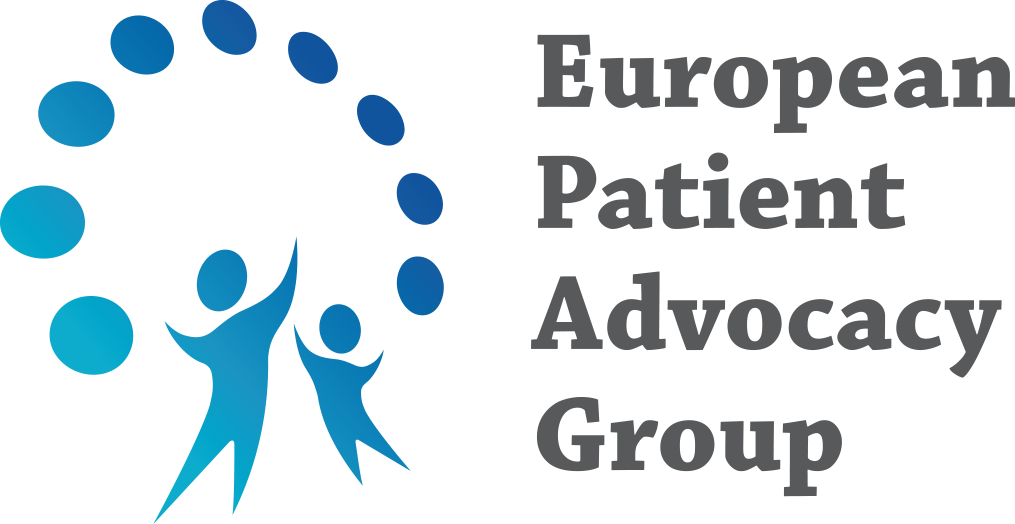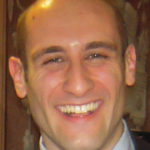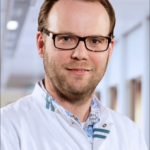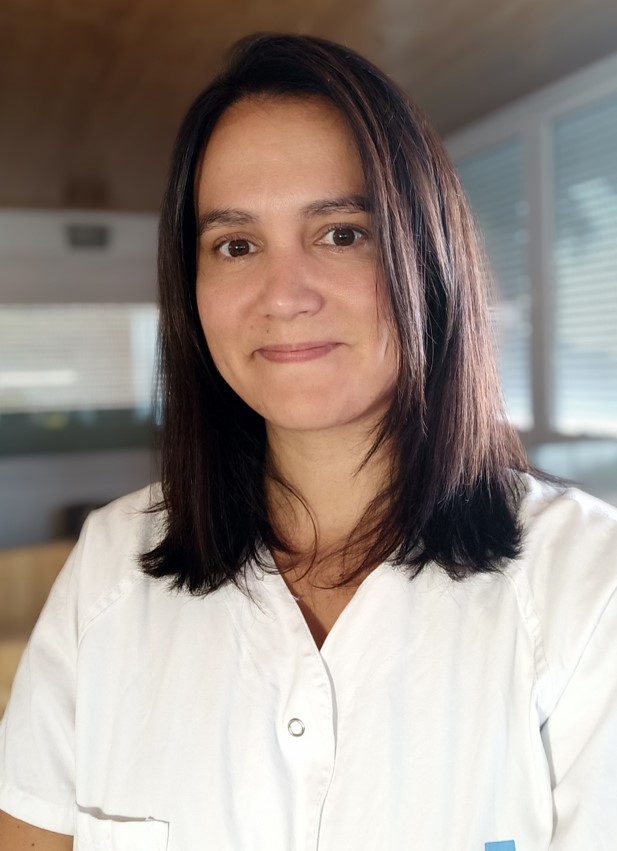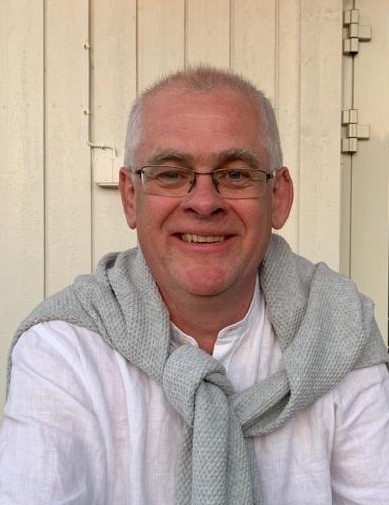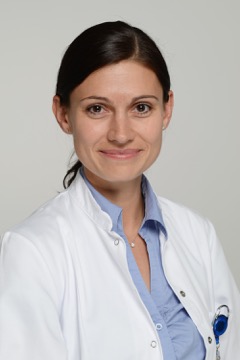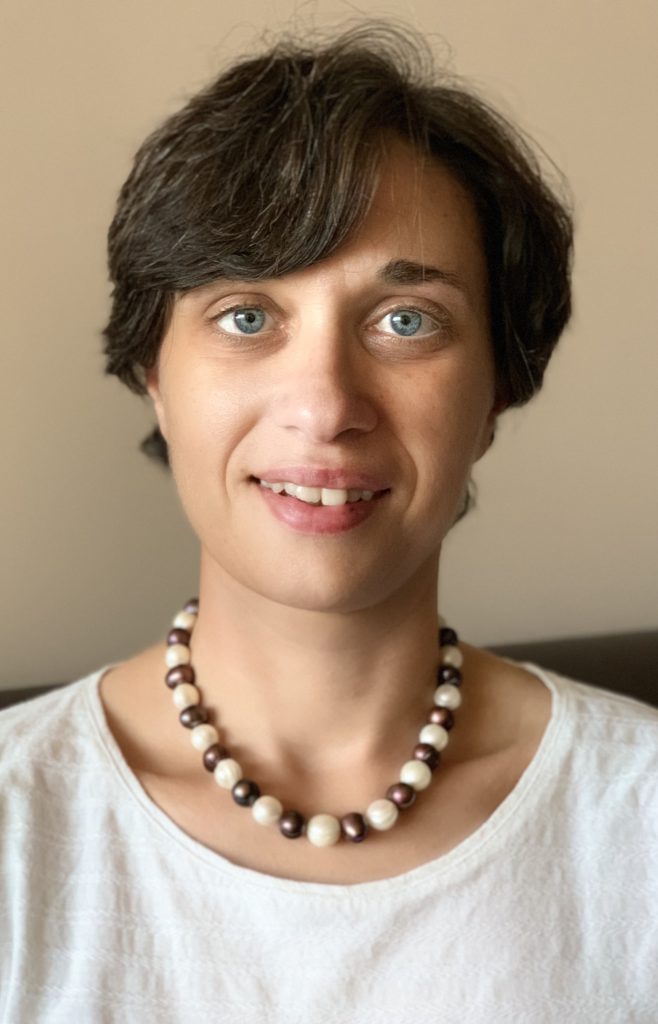The HTAD Working Group, is built upon Multidisciplinary Centres of Excellence that have been collaborating and originating much of the recent progress in understanding Heritable Thoracic Aortic Diseases
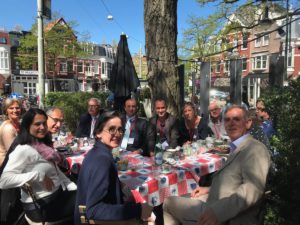
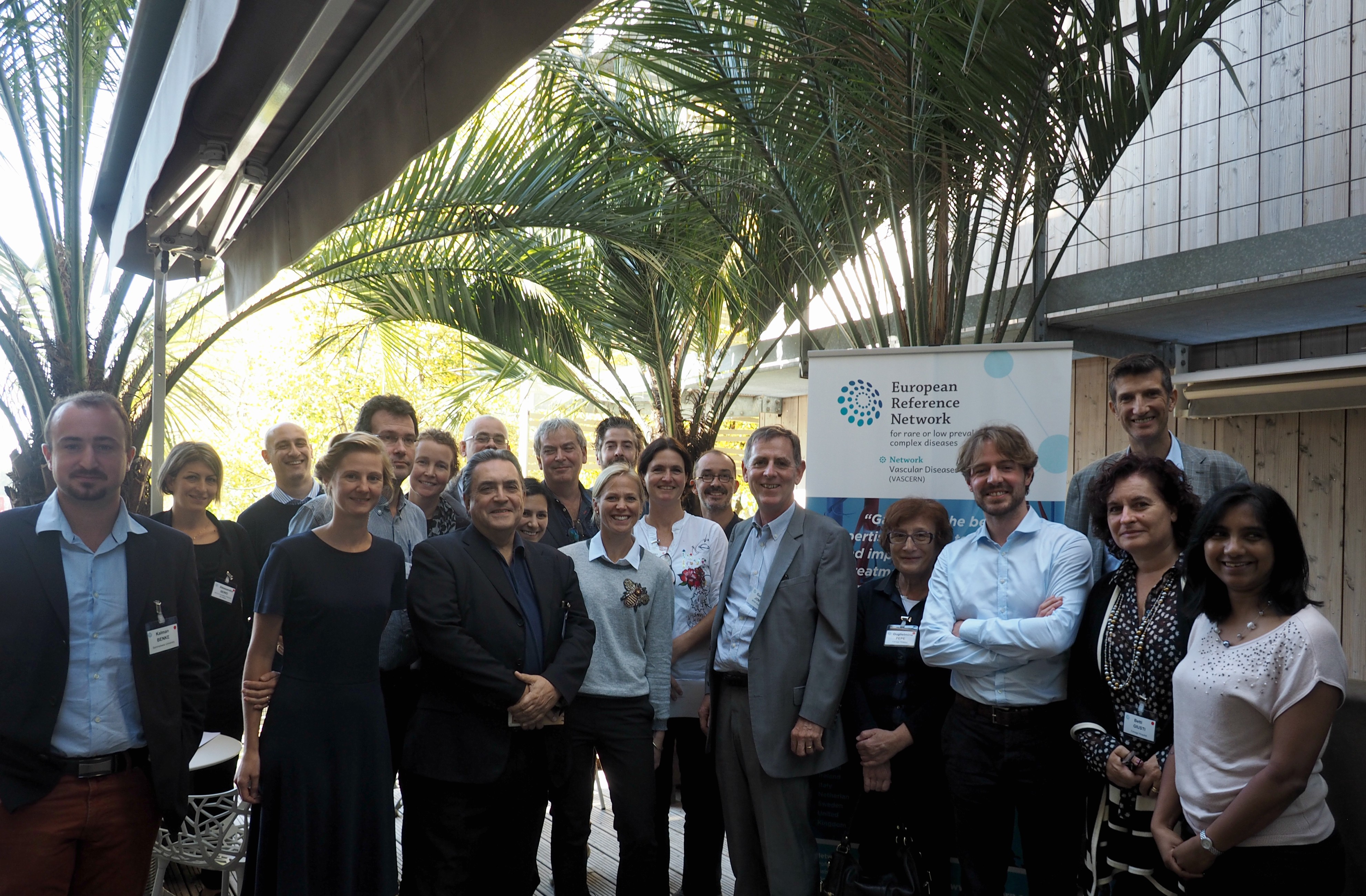
The Heritable Thoracic Aortic Diseases Working Group (HTAD WG) is one of the five Rare Disease Working Groups (RDWGs) of VASCERN that specialize in a particular type/group of rare vascular disease(s).
The HTAD-WG is chaired by Prof. Dr. Julie De Backer, from the Center for Medical Genetics and Department of Cardiology, at Ghent University Hospital, Belgium. and Co-chaired by Prof. Dr. Guillaume Jondeau, from the French Reference Centre for Marfan Syndrome and Related Syndromes at AP-HP, Hôpital Bichat-Claude Bernard in Paris, France.
The HTAD-WG cooperates with the European Patient Advocacy Group (ePAG), who is represented in the WG by ePAG Co-Chair for HTAD Elena de Moya Rubio (Marfan Hilfe (Deutschland) e.V.) and ePAG Deputy Co-Chair for HTAD Françoise Steinbach (Association Marfans).
Members of the HTAD WG are highly active in research and also collaborate with various scientific societies such as the European Society of Cardiology (ESC) and European society of Human Genetics (ESHG). They also collaborate with The Marfan Foundation, the Montalcino Aortic Consortium and the GenTAC Alliance.
Heritable Thoracic Aortic Disease (HTAD) covers disease entities with as common denominator Thoracic aortic aneurysms or –dissections that are familial and/or caused by genetic defects. Both syndromic and nonsyndromic entities exist. Although the number of genes involved in HTAD is steadily increasing, a large number of patients/families with HTAD have no identifiable defect, indicating that other genes must be involved. Genetic defects identified so far have can be categorized into (1) genes encoding components of the extracellular matrix (FBN1, MFAP5, MAT2A); (2) genes encoding components of the TGFbeta signaling pathway (TGFBR1/2, TGFB2/3, SMAD2/3); (3) genes encoding components of the smooth muscle cell contractile apparatus (ACTA2, MYH11, MYLK, PRKG1).
Clinical entities covered by this WG include:
- syndromic entities such as Marfan Syndrome (ORPHA558), Loeys Dietz Syndrome (ORPHA60030), Aneurysm Osteoarthritis syndrome (ORPHA284984), Arterial tortuosity syndrome (ORPHA3342), Multisystemic smooth muscle dysfunction syndrome (ORPHA404463) and Neonatal Marfan syndrome (ORPHA284979)
- As well as nonsyndromic entities such as Familial Thoracic Aortic Aneurysms Dissections (Familial TAAD) (ORPHA91387), Familial aortic dissection (ORPHA229),
- caused by pathogenic variants in
- actin, alpha 2, smooth muscle, aorta – ACTA2
- fibrillin 1 – FBN1
- microfibrillar associated protein 5 – MFAP5
- myosin, heavy chain 11, smooth muscle – MYH11
- myosin light chain kinase – MYLK
- protein kinase, cGMP-dependent, type I – PRKG1
- SMAD family member 3 – SMAD3
- SMAD family member 2 -SMAD2
- transforming growth factor beta 2 – TGFB2
- transforming growth factor beta 3 – TGFB3
- transforming growth factor beta receptor I – TGFBR1
- transforming growth factor beta receptor II – TGFBR2
For more information on the various diseases – click here
While our knowledge of clinical and genetic characteristics of MFS and related HTAD has increased substantially, already resulting in a better outcome in these patients, further efforts are needed to improve management and increase awareness of these rare disorders since knowledge of the disease appears to be the most important factor influencing outcome. Next stages require formal acknowledgement, status and funding to ensure personalised medicine and therapeutics.
Bases for the following estimated incidence and prevalence numbers: 500 Million inhabitants within European union with about 6 million newborns annually.
| Sub-thematic areas of expertise | Rare of complex disease(s) or condition(s) or highly specialized interventions | Code/ICD/Orphacode/Group of codes | Incidence (Number of cases/year) (in the EU) | Prevalence (in the EU) |
|---|---|---|---|---|
| HTAD | Aneurysm-Osteoarthritis Syndrome | ICD 10: 171, ORPHA284984 | 60 | 5000 |
| HTAD | Arterial Tortuosity Syndrome | ICD 10: 171, ORPHA3342 | unknown | unknown |
| HTAD | Familial bicuspid aortic valve | ICD 10: 171, ORPHA402075 | unknown | unknown |
| HTAD | Familial thoracic aortic aneurysm and aortic dissection | ICD 10: 171, ORPHA91387 | 1200 | 100000 |
| HTAD | Loeys Dietz Syndrome | ICD 10: 171, ORPHA60030 | 180 | 15000 |
| HTAD | Marfan Syndrome | ICD 10: 171, ORPHA558 | 3300 | 150000 |
| HTAD | Multisystemic smooth muscle dysfunction syndrome | ICD 10: 173, ORPHA404463 | ||
| HTAD | Rare disease with thoracic aortic aneurysm and aortic dissection | ICD 10: 171, ORPHA285014 | unknown | unknown |
All HCP in the HTAD-WG are covering this sub-thematic area of expertise.
HEALTHCARE PROVIDER (HCP) FULL MEMBERS

BELGIUM
Ghent University Hospital, Ghent, Belgium
VASCERN HTAD European Reference Centre, Dept of Cardiology and Center for Medical Genetics


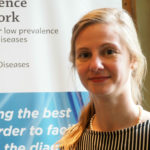
Liesbeth WILDERO VAN WOUWE
Genetic Counselor
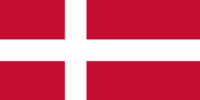
DENMARK

FRANCE
AP-HP, Hôpital Bichat-Claude Bernard, Paris, France
VASCERN HTAD European Reference Centre, CRMR MarfanSyndrome and related disorders, department of cardiology


BELGIUM
University Hospital of Antwerp, Antwerp, Belgium
VASCERN HTAD European Reference Centre, Center of Medical Genetics


GERMANY
University Medical Center Hamburg-Eppendorf, Hamburg, Germany
VASCERN HTAD European Reference Centre, University Heart Center Hamburg


HUNGARY
Semmelweis University, Budapest, Hungary
VASCERN HTAD European Reference Centre, Heart and Vascular Center


ITALY
Fondazione IRCCS Policlinico San Matteo, Pavia, Italy
VASCERN HTAD European Reference Centre, Center for Inherited Cardiovascular Diseases

Careggi Hospital, University of Florence, Florence, Italy
VASCERN HTAD European Reference Centre, Regional Tuscany Reference Center for Marfan Syndrome and related disorders


NETHERLANDS
Academic Medical Center, Amsterdam, Netherlands
VASCERN HTAD European Reference Centre, Department of Cardiology

Radboud university medical center, Nijmegen, Netherlands
VASCERN HTAD European Reference Centre, Department of Clinical Genetics

Erasmus Medical Center, Rotterdam, The Netherlands
VASCERN HTAD European Reference Centre, Department of Clinical Genetics and Cardiology

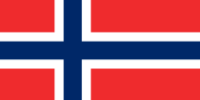
NORWAY
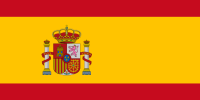
SPAIN

SWEDEN
Karolinska University Hospital, Stockholm, Sweden
VASCERN HTAD European Reference Centre, Department of Clinical Genetics

AFFILIATED PARTNERS
There are 2 types of affiliated partners:
- Associated National Centres (mainly healthcare providers) for those ERNs where an EU Member State is not yet represented by a full member in the respective ERN. It establishes a link with one specific ERN.
- A National Coordination Hub which establishes at once a link with more than one Network in which a given Member State is neither represented by a full member nor by an Associated National Centre. National Coordination Hubs may especially represent a useful solution for those Member States with very small populations that need to establish such links with many ERNs at once.
For all documents related to Affiliated Partners see the Board Statement States page here
Associated National Centres

AUSTRIA
Medical University Innsbruck, Innsbruck, Austria
Center for Genetic Aortopathies / Department of Cardiac Surgery


CYPRUS
The Cyprus Institute of Neurology and Genetics, Nicosia, Cyprus
Department of Cardiovascular Genetics & Laboratory of Forensic Genetics

National Coordination Hubs

LUXEMBOURG

MALTA
Pills of Knowledge (PoK)
Pills of Knowledge (PoK) are the deliverable for VASCERN Work Package 4 on Pills of Knowledge, defined as short single video lessons (of approximately 3-5 minutes long) in which an expert talks about a specific topic that has been selected and validated by the Rare Disease Working Groups (RDWGs).
Link to the playlist for the HTAD-WG on our YouTube Channel is here
Marfan Syndrome -Diagnosis by HTAD-WG Chair Prof Julie De Backer (Cardiologist, Ghent University Hospital, Ghent, Belgium).
This PoK gives an overview of the diagnosis of Marfan syndrome with its main clinical manifestations and diagnostic criteria described. The genetics of this rare disease are also briefly outlined in a clear and comprehensible manner. This video is a great introduction to Marfan syndrome that is suitable for both the general public and the medical community.
Video in English. Subtitles available in 7 European languages (English, French, Dutch, German, Italian, Spanish and Hungarian).
See the video here
Created by Prof. Guillaume Jondeau (Cardiologist, Assistance Publique-Hôpitaux de Paris, Hôpital Bichat-Claude Bernard, Paris, France) and Lise Murphy (European Patient Advocacy Group (ePAG) Patient Advocate Co-Chair for HTAD, Svenska Marfanföreningen, Sweden).
This Pill of Knowledge (PoK) features a conversation between a patient and doctor about the importance of physical activity and what exercise is suitable for patients with Marfan syndrome. It aims to encourage Marfan syndrome patients to participate in a suitable form of exercise 3 times a week. This message will be further shared via the 3 a week campaign.
Video in English subtitles available in 7 European languages (English, French, Dutch, Italian, Spanish, Hungarian and Swedish).
See the video here
Le Sport et le Syndrome de Marfan (Sport and Marfan syndrome)
Created by Prof. Guillaume Jondeau (Cardiologue, Assistance Publique-Hôpitaux de Paris, Hôpital Bichat-Claude Bernard, Paris, France).
This Pill of knowledge talks about how physical activity is beneficial for Marfan syndrome patients and the types of sports that are adapted for these patients and which to avoid. It is meant for patients and gives clear and simple explanations for why certain sports are well tolerated in Marfan patients and others are not.
Video in French. Subtitles available in 7 European languages (English, French, Dutch, Italian, Spanish, Hungarian and Swedish).
See the video here
What is Heritable Thoracic Aortic Disease (HTAD)?
Created by Prof. Julie De Backer (Cardiologist, Ghent University Hospital, Ghent, Belgium).
This Pill of knowledge (PoK) talks about the group of vascular diseases known as Heritable Thoracic Aortic Diseases. Both syndromic and non-syndromic forms are described and the genetics of HTAD are also explored. It is suitable for healthcare professionals and anyone wishing to learn more about HTAD.
Video in English. Subtitles in 7 European languages (English, French, Dutch, Italian, Spanish, Hungarian and Swedish).
See the video here
Role of patient advocates in a European Reference Network
This video, made by European Patient Advocacy Group (ePAG) members of VASCERN’s Heritable Thoracic Aortic Diseases Working Group, explains the role of patient advocates in the European Reference Networks.
Video in English. Subtitles available in 4 European languages (Dutch, English, French and Hungarian).
See the video here
Seven signs of Marfan syndrome by Professor Yskert von Kodolitsch
This PoK video presents the seven signs of Marfan syndrome in a clear and understandeable manner. It can help anyone who suspects that they may have Marfan syndrome to assess their probability of having this rare disease, using a simple scoring system. This is not a tool for self-diagnosis, but if you have one or more of these signs you may wish to consider consulting with a Marfan syndrome specialist who will be able to give you more information and either confirm or rule out a diagnosis of Marfan syndrome.
What to know before and during pregnancy in HTAD By Professor Jolien Roos-Hesselink and Dr. Yaso Emmanuel
This PoK video gives a comprehensive overview of the issues to consider for patients with HTAD considering pregnancy. The main considerations include risk of recurrence, risk of an aortic event (during pregnancy/delivery), risks to the foetus, risks of the medications used during pregnancy and risks of further progressive disease in the mother. Appropriate advice for each patient will need to be individualized, according to each patient’s circumstances and medical history, which is why HTAD patients should talk to their cardiologist when they are considering pregnancy.
What is aortic root replacement and when is it indicated? By Professor Zoltan Szabolcs and Dr. Kalman Benke
This PoK video presents the basics of surgical reconstruction of the aortic root. The aorta and its main complications are first briefly explained, followed by the guidelines used to indicate prophylactic surgery in HTAD patients. The two main surgical techniques – aortic root replacement (ARR) and valve sparing root replacement (VSRR) are then detailed.
How is the aorta monitored? By Dr. Gisela Teixido-Tura
This PoK gives an overview of the anatomy of the aorta as well as the imaging techniques used to visualize the aorta. These techniques, used to monitor the aorta in HTAD patients, are detailed and their special features are given. A very good overview for anyone wishing to learn more about the imaging techniques used for the monitoring and follow-up of HTAD patients.
What is chronic aortic dissection? By Professor Artur Evangelista
This PoK discusses chronic aortic dissection, including its diagnosis and management. The physical and psychological aspects to consider in patients who have experienced an aortic dissection are noted. The follow-up and possible complications after aortic dissection that can occur are also listed.
What is an acute aortic dissection? By Professor Artur Evangelista
This PoK video gives an overview of acute aortic syndrome (AAS), a term which includes aortic dissection (accounting for 80% if AAS cases), intramural hematoma (IMH; 15% of AAS cases), and penetrating aortic ulcer (5% of AAS cases). The methods for classification and diagnosis, the imaging techniques used as well as the types of surgery and medical treatments recommended for AAS are also detailed.
Webinars
VASCERN Webinar: Aortic surgery in Marfan syndrome (and other HTADs)
This webinar consists of a informative presentation followed by an interactive Q&A session. Involving clinicians and patient advocates from our Heritable Thoracic Aortic Diseases Working Group (HTAD WG): Prof. Klaus Kallenbach, Elena De Moya Rubio, and Margit Aschenbrenner.
Q&A session here. Video in English.
| HTAD and COVID-19 Q&A session | May 14th, 2020 | Watch the recording here | Access the slides here |
|---|---|---|---|
| ERN-EYE and VASCERN Joint Webinar - Marfan an update | April 27th, 2021 | Watch the recording here |
Patient Pathways aim to improve the care and management of patients with a rare disease. They include the “red flags” that may lead to the suspicion of the disease, how to reach a definite diagnosis and the management and follow-up recommendations. They are a very important tool used in defining the best patient care and will be further validated and updated when needed.
- The HTAD Patient Pathway Version 1 (issued 26/04/2018) is available here

- The HTAD Patient Pathway Version 2 (issued 29/08/2019) is available here
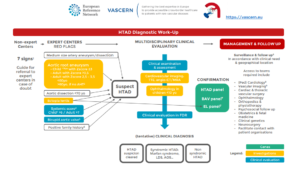
- 2020 ESC Guidelines for the management of adult congenital heart disease. Baumgartner H, De Backer J, Babu-Narayan SV, Budts W, Chessa M, Diller GP, Lung B, Kluin J, Lang IM, Meijboom F, Moons P, Mulder BJM, Oechslin E, Roos-Hesselink JW, Schwerzmann M, Sondergaard L, Zeppenfeld K; ESC Scientific Document Group.Eur Heart J. 2020 Aug 29:ehaa554. doi: 10.1093/eurheartj/ehaa554. Online ahead of print.PMID: 32860028
- Editor’sChoice – Management of Descending Thoracic Aorta Diseases: Clinical Practice Guidelines of the European Society for Vascular Surgery (ESVS).Riambau V, Böckler D, Brunkwall J, Cao P, Chiesa R, Coppi G, Czerny M, Fraedrich G, Haulon S, Jacobs MJ, Lachat ML, Moll FL, Setacci C, Taylor PR, Thompson M, Trimarchi S, Verhagen HJ, Verhoeven EL, Esvs Guidelines Committee, Kolh P, de Borst GJ, Chakfé N, Debus ES, Hinchliffe RJ, Kakkos S, Koncar I, Lindholt JS, Vega de Ceniga M, Vermassen F, Verzini F, Document Reviewers, Kolh P, Black JH 3rd, Busund R, Björck M, Dake M, Dick F, Eggebrecht H, Evangelista A, Grabenwöger M, Milner R, Naylor AR, Ricco JB, Rousseau H, Schmidli J.Eur J Vasc Endovasc Surg. 2017 Jan;53(1):4-52. doi: 10.1016/j.ejvs.2016.06.005.PMID: 28081802
- 2017 ESC/EACTSGuidelines for the management of valvular heart disease. Baumgartner H, Falk V, Bax JJ, De Bonis M, Hamm C, Holm PJ, Iung B, Lancellotti P, Lansac E, Rodriguez Muñoz D, Rosenhek R, Sjögren J, Tornos Mas P, Vahanian A, Walther T, Wendler O, Windecker S, Zamorano JL; ESC Scientific Document Group.Eur Heart J. 2017 Sep 21;38(36):2739-2791. doi: 10.1093/eurheartj/ehx391.PMID: 28886619
- Goldstein SA, Evangelista A, Abbara S, Arai A, Asch FM, Badano LP, Bolen MA, Connolly HM, Cuéllar-Calàbria H, Czerny M, Devereux RB, Erbel RA, Fattori R, Isselbacher EM, Lindsay JM, McCulloch M, Michelena HI, Nienaber CA, Oh JK, Pepi M, Taylor AJ, Weinsaft JW, Zamorano JL, Dietz H, Eagle K, Elefteriades J, Jondeau G, Rousseau H, Schepens M. Multimodality imaging of diseases of the thoracic aorta in adults: from the American Society of Echocardiography and the European Association of Cardiovascular Imaging: endorsed by the Society of Cardiovascular Computed Tomography and Society for Cardiovascular Magnetic Resonance. J Am Soc Echocardiogr. 2015 Feb;28(2):119-82. doi: 10.1016/j.echo.2014.11.015. PMID: 25623219.
- Erbel R, Aboyans V, Boileau C, Bossone E, Bartolomeo RD, Eggebrecht H, Evangelista A et all. 2014 ESC Guidelines on the diagnosis and treatment of aortic diseases: Document covering acute and chronic aortic diseases of the thoracic and abdominal aorta of the adult. The Task Force for the Diagnosis and Treatment of Aortic Diseases of the European Society of Cardiology(ESC). Eur Heart J. 2014 Nov 1; 35(41):2873-926.
- Grabenwöger M, Alfonso F, Bachet J, Bonser R, Czerny M, Eggebrecht H, Evangelista A, Fattori R, Jakob H, Lönn L, Nienaber CA, Rocchi G, Rousseau H,Thompson M, Weigang E, Erbel R; European Association for Cardio-Thoracic Surgery EACTS); European Society of Cardiology (ESC); European Association of Percutaneous Cardiovascular Interventions (EAPCI). Thoracic Endovascular Aortic Repair (TEVAR) for the treatment of aortic diseases: a position statement from the European Association for Cardio-Thoracic Surgery (EACTS) and the European Society of Cardiology (ESC), in collaboration with the European Association of Percutaneous Cardiovascular Interventions (EAPCI). Eur J Cardiothorac Surg. 2012 Jul;42(1):17-24.
- Evangelista, A. et al., 2010. Echocardiography in aortic diseases: EAE recommendations for clinical practice. European Journal of Echocardiography, 11(8), pp.645–658.
- Hiratzka, L.F. et al., 2010. 2010 ACCF/AHA/AATS/ACR/ASA/SCA/SCAI/SIR/STS/SVM guidelines for the diagnosis and management of patients with Thoracic Aortic Disease: a report of the American College of Cardiology Foundation/American Heart Association Task Force on Practice Guidelines, American Association for Thoracic Surgery, American College of Radiology, American Stroke Association, Society of Cardiovascular Anesthesiologists, Society for Cardiovascular Angiography and Interventions, Society of Interventional Radiology, Society of Thoracic Surgeons, and Society for Vascular Medicine. Circulation, 121(13), pp.e266–369.
Guidelines for the diagnosis of Marfan syndrome
9. Loeys, B.L. et al., 2010. The revised Ghent nosology for the Marfan syndrome. J Med Genet, 47(7), pp.476–485.
Guidelines for genetic testing in HTAD
10. Arslan-Kirchner, M. et al., 2015. Clinical utility gene card for: Hereditary thoracic aortic aneurysm and dissection including next-generation sequencing-based approaches. European Journal of Human Genetics.
11. Clinical Validity of Genes for Heritable Thoracic Aortic Aneurysm and Dissection. Renard M, Francis C, Ghosh R, Scott AF, Witmer PD, Adès LC, Andelfinger GU, Arnaud P, Boileau C, Callewaert BL, Guo D, Hanna N, Lindsay ME, Morisaki H, Morisaki T, Pachter N, Robert L, Van Laer L, Dietz HC, Loeys BL, Milewicz DM, De Backer J. J Am Coll Cardiol. 2018 Aug 7;72(6):605-615. doi: 10.1016/j.jacc.2018.04.089.PMID: 30071989
Guidelines on management of aortic disease in pregnancy
12. 2018 ESC Guidelines for the management of cardiovascular diseases during pregnancy. Regitz-Zagrosek V, Roos-Hesselink JW, Bauersachs J, Blomström-Lundqvist C, Cífková R, De Bonis M, Iung B, Johnson MR, Kintscher U, Kranke P, Lang IM, Morais J, Pieper PG, Presbitero P, Price S, Rosano GMC, Seeland U, Simoncini T, Swan L, Warnes CA; ESC Scientific Document Group.Eur Heart J. 2018 Sep 7;39(34):3165-3241. doi: 10.1093/eurheartj/ehy340.PMID: 30165544 No abstract available.
13. Wanga, S. et al., 2016. Pregnancy and Thoracic Aortic Disease: Managing the Risks. The Canadian journal of cardiology, 32(1), pp.78–85.
Planned Clinical Practice Guidelines to be written by the HTAD WG
Guidelines on diagnosis and management of HTAD
Consensus statement of the VASCERN HTAD Working Group (January 23, 2019):
In patients with HTAD, Fluoroquinolones should be used with caution because of a possible risk for exacerbation of aortic disease. The use of alternatives is preferred while awaiting further evidence.
Consensus statement for the screening and management of patients with pathogenic ACTA2 variants (November 21, 2019)
Ingrid M. B. H. van de Laar, Eloisa Arbustini, Bart Loeys, Erik Björck, Lise Murphy, Maarten Groenink, Marlies Kempers, Janneke Timmermans, Jolien Roos-Hesselink, Kalman Benke, Guglielmina Pepe, Barbara Mulder, Zoltan Szabolcs, Gisela Teixidó-Turà, Leema Robert, Yaso Emmanuel, Arturo Evangelista, Alessandro Pini, Yskert von Kodolitsch, Guillaume Jondeau, Julie De Backer European reference network for rare vascular diseases (VASCERN) consensus statement for the screening and management of patients with pathogenic ACTA2 variants. Orphanet J Rare Dis14, 264 (2019) doi:10.1186/s13023-019-1186-2
VASCERN Heritable Thoracic Aortic Diseases (HTAD) Working Group statement on COVID-19 (March 2020)
This statement can equally be found in:
Dutch: VASCERN HTAD verklaring over Covid 19
German: VASCERN Erklärung zu Covid 19
All Marfan syndrome and Related Disorders Factsheets in one document: 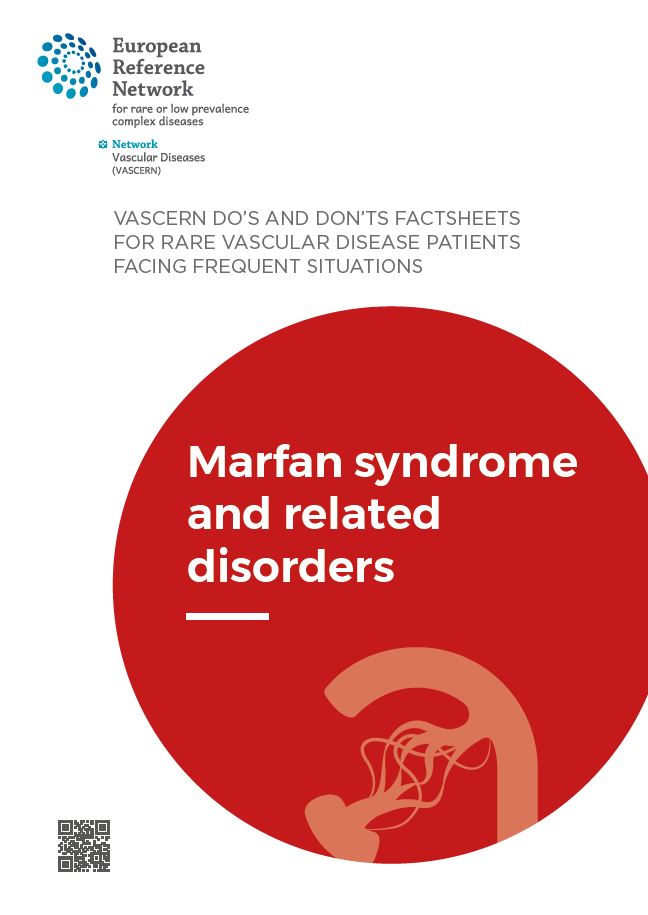
Marfan syndrome and Related Disorders Do’s and Don’ts
Individual factsheets for each topic:
Pregnancy delivery and postpartum care
Antiplatelet agents and anticoagulants
Colonoscopy gastroscopy and laparoscopy
Extra-aortic peripheral arterial dissection
Abdominal gastrointestinal gynaecological emergencies
Translations in other EU languages are available here
The HTAD-WG is currently working on defining their clinical outcome measures for Marfan syndrome.
A first outcome measure process is about patient reported outcomes and will address patient needs
A second outcome measure process assesses the indications and outcome of genetic testing for HTAD
The HTAD Registry project will consist of the adaptation of the already existing registry developed by Assistance-Publique Hôpitaux de Paris for the group “Heritable Thoracic Aortic Diseases”, dealing with Marfan syndrome and other genetic diseases of the aorta. The necessary modifications of this database to make it available to all VASCERN HCPs and make the registry FAIR are now underway.
The HTAD WG are also participating in the European Society of Cardiology’s Registry of Pregnancy and Cardiac disease III (ROPAC III)
More information on the Registry WG page here.
Current collaborative research studies ongoing
- F101 Genomes study: Paris, Ghent and Antwerp HCPs involved
- Arrhythmias and cardiac function in heritable thoracic aortic diseases: Barcelona, Malta, Paris, Ghent, and Hamburg HCPs involved
The PubMed List of HTAD 201 publications from the Working Group Members (from 2015-present) is provided, and emphasizes the importance of continued clinician education.
- Year 1: Collaborative Publications
Arterial tortuosity syndrome: 40 new families and literature review.Beyens A, Albuisson J, Boel A, Al-Essa M, Al-Manea W, Bonnet D, Bostan O, Boute O, Busa T, Canham N, Cil E, Coucke PJ, Cousin MA, Dasouki M, De Backer J, De Paepe A, De Schepper S, De Silva D, Devriendt K, De Wandele I, Deyle DR, Dietz H, Dupuis-Girod S, Fontenot E, Fischer-Zirnsak B, Gezdirici A, Ghoumid J, Giuliano F, Diéz NB, Haider MZ, Hardin JS, Jeunemaitre X, Klee EW, Kornak U, Landecho MF, Legrand A, Loeys B, Lyonnet S, Michael H, Moceri P, Mohammed S, Muiño-Mosquera L, Nampoothiri S, Pichler K, Prescott K, Rajeb A, Ramos-Arroyo M, Rossi M, Salih M, Seidahmed MZ, Schaefer E, Steichen-Gersdorf E, Temel S, Uysal F, Vanhomwegen M, Van Laer L, Van Maldergem L, Warner D, Willaert A, Collins TR, Taylor A, Davis EC, Zarate Y, CallewaertB.Genet Med. 2018 Jan 11. doi: 10.1038/gim.2017.253. [Epub ahead of print] PMID: 29323665
Pregnancy in Women With SMAD3 Mutation.van Hagen IM, van der Linde D, van de Laar IM, MuiñoMosquera L, De Backer J, Roos-Hesselink JW. J Am CollCardiol. 2017 Mar 14;69(10):1356-1358. doi: 10.1016/j.jacc.2016.12.029. No abstract available. PMID: 28279300
Organisation of care for pregnancy in patients with congenital heart disease. Roos-Hesselink JW1, Budts W2, Walker F3, De Backer JFA4, Swan L5, Stones W6,7, Kranke P8,9, Sliwa-Hahnle K10,11, Johnson MR12. Heart. 2017 Dec;103(23):1854-1859. doi: 10.1136/heartjnl-2017-311758. Epub 2017 Jul 24. PMID: 28739807
Homozygous and compound heterozygous mutations in the FBN1 gene: unexpected findings in molecular diagnosis of Marfan syndrome.Arnaud P, Hanna N, Aubart M, Leheup B, Dupuis-Girod S, Naudion S, Lacombe D, Milleron O, Odent S, Faivre L, Bal L, Edouard T, Collod-Beroud G, Langeois M, Spentchian M, Gouya L, Jondeau G, Boileau C.J Med Genet. 2017 Feb;54(2):100-103. doi: 10.1136/jmedgenet-2016-103996. Epub 2016 Aug 31. PMID: 27582083
A mutation update on the LDS associated genes TGFB2/3 and SMAD2/3. Schepers D, Tortora G, Morisaki H, MacCarrick G, Lindsay M, Liang D, Mehta SG, Hague J, Verhagen J, van de Laar I, Wessels M, Detisch Y, van Haelst M, Baas A, Lichtenbelt K, Braun K, van der Linde D, Roos-Hesselink J, McGillivray G, Meester J, Maystadt I, Coucke P, El-Khoury E, Parkash S, Diness B, Risom L, Scurr I, Hilhorst-Hofstee Y, Morisaki T, Richer J, Désir J, Kempers M, Rideout AL, Horne G, Bennett C, Rahikkala E, Vandeweyer G, Alaerts M, Verstraeten A, Dietz H, Van Laer L, Loeys B. Hum Mutat. 2018 Feb 1. doi: 10.1002/humu.23407. [Epub ahead of print]
- Year 2 : Collaboarative Publications
SMAD3 pathogenic variants: risk for thoracic aortic disease and associated complications from the Montalcino Aortic Consortium. Hostetler EM, Regalado ES, Guo DC, Hanna N, Arnaud P, Muiño-Mosquera L, Callewaert BL, Lee K, Leal SM, Wallace SE, Rideout AL, Dyack S, Aatre RD, Boileau C, De Backer J, Jondeau G, Milewicz DM.J Med Genet. 2019 Jan 19. pii: jmedgenet-2018-105583. doi: 10.1136/jmedgenet-2018-105583. [Epub ahead of print] PMID: 30661052
Hungarian Marfan family with large FBN1 deletion calls attention to copy number variation detection in the current NGS era. Benke K, Ágg B, Meienberg J, Kopps AM, Fattorini N, Stengl R, Daradics N, Pólos M, Bors A, Radovits T, Merkely B, De Backer J, Szabolcs Z, Mátyás G.J Thorac Dis. 2018 Apr;10(4):2456-2460. doi: 10.21037/jtd.2018.04.40. PMID: 29850152
Clinical Validity of Genes for Heritable Thoracic Aortic Aneurysm and Dissection.Renard M, Francis C, Ghosh R, Scott AF, Witmer PD, Adès LC, Andelfinger GU, Arnaud P, Boileau C, Callewaert BL, Guo D, Hanna N, Lindsay ME, Morisaki H, Morisaki T, Pachter N, Robert L, Van Laer L, Dietz HC, Loeys BL, Milewicz DM, De Backer J. J Am Coll Cardiol. 2018 Aug 7;72(6):605-615. doi: 10.1016/j.jacc.2018.04.089.PMID: 30071989
Expert consensus recommendations on the cardiogenetic care for patients with thoracic aortic disease and their first-degree relatives.Verhagen JMA, Kempers M, Cozijnsen L, Bouma BJ, Duijnhouwer AL, Post JG, Hilhorst-Hofstee Y, Bekkers SCAM, Kerstjens-Frederikse WS, van Brakel TJ, Lambermon E, Wessels MW, Loeys BL, Roos-Hesselink JW, van de Laar IMBH; National Working Group on BAV & TAA. Int J Cardiol. 2018 May 1;258:243-248. doi: 10.1016/j.ijcard.2018.01.145. Epub 2018 Feb 7. Review. PMID: 29452988
Results of next-generation sequencing gene panel diagnostics including copy-number variation analysis in 810 patients suspected of heritable thoracic aortic disorders. Overwater E, Marsili L, Baars MJH, Baas AF, van de Beek I, Dulfer E, van Hagen JM, Hilhorst-Hofstee Y, Kempers M, Krapels IP, Menke LA, Verhagen JMA, Yeung KK, Zwijnenburg PJG, Groenink M, van Rijn P, Weiss MM, Voorhoeve E, van Tintelen JP, Houweling AC, Maugeri A.Hum Mutat. 2018 Sep;39(9):1173-1192. doi: 10.1002/humu.23565. Epub 2018 Jul 12.
Novel pathogenic SMAD2 variants in five families with arterial aneurysm and dissection: further delineation of the phenotype.Cannaerts E, Kempers M, Maugeri A, Marcelis C, Gardeitchik T, Richer J, Micha D, Beauchesne L, Timmermans J, Vermeersch P, Meyten N, Chénier S, van de Beek G, Peeters N, Alaerts M, Schepers D, Van Laer L, Verstraeten A, Loeys B.J Med Genet. 2018 Jul 2. pii: jmedgenet-2018-105304. doi: 10.1136/jmedgenet-2018-105304. [Epub ahead of print]PMID: 29967133
A mutation update on the LDS-associated genes TGFB2/3 and SMAD2/3.Schepers D, Tortora G, Morisaki H, MacCarrick G, Lindsay M, Liang D, Mehta SG, Hague J, Verhagen J, van de Laar I, Wessels M, Detisch Y, van Haelst M, Baas A, Lichtenbelt K, Braun K, van der Linde D, Roos-Hesselink J, McGillivray G, Meester J, Maystadt I, Coucke P, El-Khoury E, Parkash S, Diness B, Risom L, Scurr I, Hilhorst-Hofstee Y, Morisaki T, Richer J, Désir J, Kempers M, Rideout AL, Horne G, Bennett C, Rahikkala E, Vandeweyer G, Alaerts M, Verstraeten A, Dietz H, Van Laer L, Loeys B. Hum Mutat. 2018 May;39(5):621-634. doi: 10.1002/humu.23407. Epub 2018 Mar 6. PMID: 29392890
- Year 3-5 Collaborative Publications
Campens L, Baris L, Scott NS, Broberg CS, Bondue A, Jondeau G, Grewal J, Johnson MR, Hall R, De Backer J, Roos-Hesselink JW; ROPAC investigators group. Pregnancy outcome in thoracic aortic disease data from the Registry Of Pregnancy And Cardiac disease Heart. 2021 Jan 19:heartjnl-2020-318183. doi: 10.1136/heartjnl-2020-318183. Epub ahead of print. PMID: 33468574.
Pathogenic variants in THSD4, encoding the ADAMTS-like 6 protein, predispose to inherited thoracic aortic aneurysm. Elbitar S, Renard M, Arnaud P, Hanna N, Jacob MP, Guo DC, Tsutsui K, Gross MS, Kessler K, Tosolini L, Dattilo V, Dupont S, Jonquet J, Langeois M, Benarroch L, Aubart M, Ghaleb Y, Abou Khalil Y, Varret M, El Khoury P, Ho-Tin-Noé B, Alembik Y, Gaertner S, Isidor B, Gouya L, Milleron O, Sekiguchi K, Milewicz D, De Backer J, Le Goff C, Michel JB, Jondeau G, Sakai LY, Boileau C, Abifadel M.Genet Med. 2020 Aug 28. doi: 10.1038/s41436-020-00947-4. Online ahead of print.PMID: 32855533
*Features of Marfan syndrome not listed in the Ghent nosology – The Dark Side of the Disease.von Kodolitsch Y, Demolder A, Girdauskas E, Kaemmerer H, Kornhuber K, Muino Mosquera L, Morris S, Neptune E, Pyeritz R, Rand-Hendriksen S, Rahman A, Riise N, Robert L, Staufenbiel I, Szöcs K, Vanem TT, Linke SJ, Vogler M, Yetman A, De Backer J.Expert Rev Cardiovasc Ther. 2019 Dec 12. doi: 10.1080/14779072.2019.1704625. [Epub ahead of print]PMID: 31829751
*J Clin Med. 2019 Nov 29;8(12). pii: E2079. doi: 10.3390/jcm8122079. Case-matched Comparison of Cardiovascular Outcome in Loeys-Dietz Syndrome versus Marfan Syndrome. Mühlstädt K1, De Backer J2,3, von Kodolitsch Y1, Kutsche K4, Muiño Mosquera L2, Brickwedel J1, Girdauskas E1, Mir TS1, Mahlmann A5, Tsilimparis N1, Staebler A6, Schoof L1, Seidel H7, Berger J8, Bernhardt AM1, Blankenberg S1, Kölbel T1, Detter C1, Szöcs K1, Kaemmerer H9.
*European reference network for rare vascular diseases (VASCERN) consensus statement for the screening and management of patients with pathogenic ACTA2 variants. van de Laar IMBH, Arbustini E, Loeys B, Björck E, Murphy L, Groenink M, Kempers M, Timmermans J, Roos-Hesselink J, Benke K, Pepe G, Mulder B, Szabolcs Z, Teixidó-Turà G, Robert L, Emmanuel Y, Evangelista A, Pini A, von Kodolitsch Y, Jondeau G, De Backer J.Orphanet J Rare Dis. 2019 Nov 21;14(1):264. doi: 10.1186/s13023-019-1186-2.PMID: 31752940 Free PMC Article
*Genetic counselling and testing in adults with congenital heart disease: A consensus document of the ESC Working Group of Grown-Up Congenital Heart Disease, the ESC Working Group on Aorta and Peripheral Vascular Disease and the European Society of Human Genetics.De Backer J, Bondue A, Budts W, Evangelista A, Gallego P, Jondeau G, Loeys B, Peña ML, Teixido-Tura G, van de Laar I, Verstraeten A, Roos Hesselink J.Eur J Prev Cardiol. 2019 Jun 11:2047487319854552. doi: 10.1177/2047487319854552. [Epub ahead of print]PMID: 31184212
*Curr Opin Cardiol. 2019 Aug 7. doi: 10.1097/HCO.0000000000000669. [Epub ahead of print]Genetic testing for aortopathies: primer for the nongeneticist. De Backer J1,2, Jondeau G3,2, Boileau C3,4,5.
Eur Heart J. 2019 Mar 25. pii: ehz136. doi: 10.1093/eurheartj/ehz136. [Epub ahead of print] Pregnancy outcomes in women with cardiovascular disease: evolving trends over 10 years in the ESC Registry Of Pregnancy And Cardiac disease (ROPAC).Roos-Hesselink J1,2, Baris L1, Johnson M3, De Backer J4, Otto C5, Marelli A6, Jondeau G7, Budts W8, Grewal J9, Sliwa K10, Parsonage W11, Maggioni AP2,12, van Hagen I1, Vahanian A2,7, Tavazzi L13, Elkayam U14, Boersma E1, Hall R15.
*Pregnancy outcome in thoracic aortic disease data from the Registry Of Pregnancy And Cardiac disease. Campens L, Baris L, Scott NS, Broberg CS, Bondue A, Jondeau G, Grewal J, Johnson MR, Hall R, De Backer J, Roos-Hesselink JW; ROPAC investigators group.Heart. 2021 Jan 19:heartjnl-2020-318183. doi: 10.1136/heartjnl-2020-318183. Online ahead of print.PMID: 33468574
Aortic disease in Marfan syndrome is caused by overactivation of sGC-PRKG signaling by NO.de la Fuente-Alonso A, Toral M, Alfayate A, Ruiz-Rodríguez MJ, Bonzón-Kulichenko E, Teixido-Tura G, Martínez-Martínez S, Méndez-Olivares MJ, López-Maderuelo D, González-Valdés I, Garcia-Izquierdo E, Mingo S, Martín CE, Muiño-Mosquera L, De Backer J, Nistal JF, Forteza A, Evangelista A, Vázquez J, Campanero MR, Redondo JM.Nat Commun. 2021 May 11;12(1):2628. doi: 10.1038/s41467-021-22933-3.PMID: 33976159
* = VASCERN acknowledged
Current collaborative research studies ongoing
- F101 Genomes study: Paris, Ghent and Antwerp HCPs involved
- Arrhythmias and cardiac function in heritable thoracic aortic diseases: Barcelona, Malta, Paris, Ghent, and Hamburg HCPs involved
Year 1: Collaborative Publications
Arterial tortuosity syndrome: 40 new families and literature review.Beyens A, Albuisson J, Boel A, Al-Essa M, Al-Manea W, Bonnet D, Bostan O, Boute O, Busa T, Canham N, Cil E, Coucke PJ, Cousin MA, Dasouki M, De Backer J, De Paepe A, De Schepper S, De Silva D, Devriendt K, De Wandele I, Deyle DR, Dietz H, Dupuis-Girod S, Fontenot E, Fischer-Zirnsak B, Gezdirici A, Ghoumid J, Giuliano F, Diéz NB, Haider MZ, Hardin JS, Jeunemaitre X, Klee EW, Kornak U, Landecho MF, Legrand A, Loeys B, Lyonnet S, Michael H, Moceri P, Mohammed S, Muiño-Mosquera L, Nampoothiri S, Pichler K, Prescott K, Rajeb A, Ramos-Arroyo M, Rossi M, Salih M, Seidahmed MZ, Schaefer E, Steichen-Gersdorf E, Temel S, Uysal F, Vanhomwegen M, Van Laer L, Van Maldergem L, Warner D, Willaert A, Collins TR, Taylor A, Davis EC, Zarate Y, CallewaertB.Genet Med. 2018 Jan 11. doi: 10.1038/gim.2017.253. [Epub ahead of print] PMID: 29323665
Pregnancy in Women With SMAD3 Mutation.van Hagen IM, van der Linde D, van de Laar IM, MuiñoMosquera L, De Backer J, Roos-Hesselink JW. J Am CollCardiol. 2017 Mar 14;69(10):1356-1358. doi: 10.1016/j.jacc.2016.12.029. No abstract available. PMID: 28279300
Organisation of care for pregnancy in patients with congenital heart disease. Roos-Hesselink JW1, Budts W2, Walker F3, De Backer JFA4, Swan L5, Stones W6,7, Kranke P8,9, Sliwa-Hahnle K10,11, Johnson MR12. Heart. 2017 Dec;103(23):1854-1859. doi: 10.1136/heartjnl-2017-311758. Epub 2017 Jul 24. PMID: 28739807
Homozygous and compound heterozygous mutations in the FBN1 gene: unexpected findings in molecular diagnosis of Marfan syndrome.Arnaud P, Hanna N, Aubart M, Leheup B, Dupuis-Girod S, Naudion S, Lacombe D, Milleron O, Odent S, Faivre L, Bal L, Edouard T, Collod-Beroud G, Langeois M, Spentchian M, Gouya L, Jondeau G, Boileau C.J Med Genet. 2017 Feb;54(2):100-103. doi: 10.1136/jmedgenet-2016-103996. Epub 2016 Aug 31. PMID: 27582083
Impaired Central Pulsatile Hemodynamics in Children and Adolescents With Marfan Syndrome. Grillo A, Salvi P, Marelli S, Gao L, Salvi L, Faini A, Trifirò G, Carretta R, Pini A, Parati G. J Am Heart Assoc. 2017 Nov 7;6(11):e006815. doi: 10.1161/JAHA.117.006815. PMID: 29114001; PMCID: PMC5721771.
A mutation update on the LDS associated genes TGFB2/3 and SMAD2/3. Schepers D, Tortora G, Morisaki H, MacCarrick G, Lindsay M, Liang D, Mehta SG, Hague J, Verhagen J, van de Laar I, Wessels M, Detisch Y, van Haelst M, Baas A, Lichtenbelt K, Braun K, van der Linde D, Roos-Hesselink J, McGillivray G, Meester J, Maystadt I, Coucke P, El-Khoury E, Parkash S, Diness B, Risom L, Scurr I, Hilhorst-Hofstee Y, Morisaki T, Richer J, Désir J, Kempers M, Rideout AL, Horne G, Bennett C, Rahikkala E, Vandeweyer G, Alaerts M, Verstraeten A, Dietz H, Van Laer L, Loeys B. Hum Mutat. 2018 Feb 1. doi: 10.1002/humu.23407. [Epub ahead of print]
Year 2 : Collaboarative Publications
SMAD3 pathogenic variants: risk for thoracic aortic disease and associated complications from the Montalcino Aortic Consortium. Hostetler EM, Regalado ES, Guo DC, Hanna N, Arnaud P, Muiño-Mosquera L, Callewaert BL, Lee K, Leal SM, Wallace SE, Rideout AL, Dyack S, Aatre RD, Boileau C, De Backer J, Jondeau G, Milewicz DM.J Med Genet. 2019 Jan 19. pii: jmedgenet-2018-105583. doi: 10.1136/jmedgenet-2018-105583. [Epub ahead of print] PMID: 30661052
Hungarian Marfan family with large FBN1 deletion calls attention to copy number variation detection in the current NGS era. Benke K, Ágg B, Meienberg J, Kopps AM, Fattorini N, Stengl R, Daradics N, Pólos M, Bors A, Radovits T, Merkely B, De Backer J, Szabolcs Z, Mátyás G.J Thorac Dis. 2018 Apr;10(4):2456-2460. doi: 10.21037/jtd.2018.04.40. PMID: 29850152
Clinical Validity of Genes for Heritable Thoracic Aortic Aneurysm and Dissection.Renard M, Francis C, Ghosh R, Scott AF, Witmer PD, Adès LC, Andelfinger GU, Arnaud P, Boileau C, Callewaert BL, Guo D, Hanna N, Lindsay ME, Morisaki H, Morisaki T, Pachter N, Robert L, Van Laer L, Dietz HC, Loeys BL, Milewicz DM, De Backer J. J Am Coll Cardiol. 2018 Aug 7;72(6):605-615. doi: 10.1016/j.jacc.2018.04.089.PMID: 30071989
Expert consensus recommendations on the cardiogenetic care for patients with thoracic aortic disease and their first-degree relatives.Verhagen JMA, Kempers M, Cozijnsen L, Bouma BJ, Duijnhouwer AL, Post JG, Hilhorst-Hofstee Y, Bekkers SCAM, Kerstjens-Frederikse WS, van Brakel TJ, Lambermon E, Wessels MW, Loeys BL, Roos-Hesselink JW, van de Laar IMBH; National Working Group on BAV & TAA. Int J Cardiol. 2018 May 1;258:243-248. doi: 10.1016/j.ijcard.2018.01.145. Epub 2018 Feb 7. Review. PMID: 29452988
Results of next-generation sequencing gene panel diagnostics including copy-number variation analysis in 810 patients suspected of heritable thoracic aortic disorders. Overwater E, Marsili L, Baars MJH, Baas AF, van de Beek I, Dulfer E, van Hagen JM, Hilhorst-Hofstee Y, Kempers M, Krapels IP, Menke LA, Verhagen JMA, Yeung KK, Zwijnenburg PJG, Groenink M, van Rijn P, Weiss MM, Voorhoeve E, van Tintelen JP, Houweling AC, Maugeri A.Hum Mutat. 2018 Sep;39(9):1173-1192. doi: 10.1002/humu.23565. Epub 2018 Jul 12.
Novel pathogenic SMAD2 variants in five families with arterial aneurysm and dissection: further delineation of the phenotype.Cannaerts E, Kempers M, Maugeri A, Marcelis C, Gardeitchik T, Richer J, Micha D, Beauchesne L, Timmermans J, Vermeersch P, Meyten N, Chénier S, van de Beek G, Peeters N, Alaerts M, Schepers D, Van Laer L, Verstraeten A, Loeys B.J Med Genet. 2018 Jul 2. pii: jmedgenet-2018-105304. doi: 10.1136/jmedgenet-2018-105304. [Epub ahead of print]PMID: 29967133
A mutation update on the LDS-associated genes TGFB2/3 and SMAD2/3.Schepers D, Tortora G, Morisaki H, MacCarrick G, Lindsay M, Liang D, Mehta SG, Hague J, Verhagen J, van de Laar I, Wessels M, Detisch Y, van Haelst M, Baas A, Lichtenbelt K, Braun K, van der Linde D, Roos-Hesselink J, McGillivray G, Meester J, Maystadt I, Coucke P, El-Khoury E, Parkash S, Diness B, Risom L, Scurr I, Hilhorst-Hofstee Y, Morisaki T, Richer J, Désir J, Kempers M, Rideout AL, Horne G, Bennett C, Rahikkala E, Vandeweyer G, Alaerts M, Verstraeten A, Dietz H, Van Laer L, Loeys B. Hum Mutat. 2018 May;39(5):621-634. doi: 10.1002/humu.23407. Epub 2018 Mar 6. PMID: 29392890
Year 3-5 Collaborative Publications
athogenic variants in THSD4, encoding the ADAMTS-like 6 protein, predispose to inherited thoracic aortic aneurysm. Elbitar S, Renard M, Arnaud P, Hanna N, Jacob MP, Guo DC, Tsutsui K, Gross MS, Kessler K, Tosolini L, Dattilo V, Dupont S, Jonquet J, Langeois M, Benarroch L, Aubart M, Ghaleb Y, Abou Khalil Y, Varret M, El Khoury P, Ho-Tin-Noé B, Alembik Y, Gaertner S, Isidor B, Gouya L, Milleron O, Sekiguchi K, Milewicz D, De Backer J, Le Goff C, Michel JB, Jondeau G, Sakai LY, Boileau C, Abifadel M.Genet Med. 2020 Aug 28. doi: 10.1038/s41436-020-00947-4. Online ahead of print.PMID: 32855533
*Features of Marfan syndrome not listed in the Ghent nosology – The Dark Side of the Disease.von Kodolitsch Y, Demolder A, Girdauskas E, Kaemmerer H, Kornhuber K, Muino Mosquera L, Morris S, Neptune E, Pyeritz R, Rand-Hendriksen S, Rahman A, Riise N, Robert L, Staufenbiel I, Szöcs K, Vanem TT, Linke SJ, Vogler M, Yetman A, De Backer J.Expert Rev Cardiovasc Ther. 2019 Dec 12. doi: 10.1080/14779072.2019.1704625. [Epub ahead of print]PMID: 31829751
*J Clin Med. 2019 Nov 29;8(12). pii: E2079. doi: 10.3390/jcm8122079. Case-matched Comparison of Cardiovascular Outcome in Loeys-Dietz Syndrome versus Marfan Syndrome. Mühlstädt K1, De Backer J2,3, von Kodolitsch Y1, Kutsche K4, Muiño Mosquera L2, Brickwedel J1, Girdauskas E1, Mir TS1, Mahlmann A5, Tsilimparis N1, Staebler A6, Schoof L1, Seidel H7, Berger J8, Bernhardt AM1, Blankenberg S1, Kölbel T1, Detter C1, Szöcs K1, Kaemmerer H9.
*European reference network for rare vascular diseases (VASCERN) consensus statement for the screening and management of patients with pathogenic ACTA2 variants. van de Laar IMBH, Arbustini E, Loeys B, Björck E, Murphy L, Groenink M, Kempers M, Timmermans J, Roos-Hesselink J, Benke K, Pepe G, Mulder B, Szabolcs Z, Teixidó-Turà G, Robert L, Emmanuel Y, Evangelista A, Pini A, von Kodolitsch Y, Jondeau G, De Backer J.Orphanet J Rare Dis. 2019 Nov 21;14(1):264. doi: 10.1186/s13023-019-1186-2.PMID: 31752940 Free PMC Article
*Genetic counselling and testing in adults with congenital heart disease: A consensus document of the ESC Working Group of Grown-Up Congenital Heart Disease, the ESC Working Group on Aorta and Peripheral Vascular Disease and the European Society of Human Genetics.De Backer J, Bondue A, Budts W, Evangelista A, Gallego P, Jondeau G, Loeys B, Peña ML, Teixido-Tura G, van de Laar I, Verstraeten A, Roos Hesselink J.Eur J Prev Cardiol. 2019 Jun 11:2047487319854552. doi: 10.1177/2047487319854552. [Epub ahead of print]PMID: 31184212
*Curr Opin Cardiol. 2019 Aug 7. doi: 10.1097/HCO.0000000000000669. [Epub ahead of print]Genetic testing for aortopathies: primer for the nongeneticist. De Backer J1,2, Jondeau G3,2, Boileau C3,4,5.
Eur Heart J. 2019 Mar 25. pii: ehz136. doi: 10.1093/eurheartj/ehz136. [Epub ahead of print] Pregnancy outcomes in women with cardiovascular disease: evolving trends over 10 years in the ESC Registry Of Pregnancy And Cardiac disease (ROPAC).Roos-Hesselink J1,2, Baris L1, Johnson M3, De Backer J4, Otto C5, Marelli A6, Jondeau G7, Budts W8, Grewal J9, Sliwa K10, Parsonage W11, Maggioni AP2,12, van Hagen I1, Vahanian A2,7, Tavazzi L13, Elkayam U14, Boersma E1, Hall R15.
Myocardial Function, Heart Failure and Arrhythmia in Marfan Syndrome: A Systematic Literature Review. Demolder A, von Kodolitsch Y, Muiño-Mosquera L, De Backer J. Diagnostics (Basel). 2020 Sep 25;10(10):751. doi: 10.3390/diagnostics10100751. PMID: 32992882; PMCID: PMC7599866.
*Pregnancy outcome in thoracic aortic disease data from the Registry Of Pregnancy And Cardiac disease. Campens L, Baris L, Scott NS, Broberg CS, Bondue A, Jondeau G, Grewal J, Johnson MR, Hall R, De Backer J, Roos-Hesselink JW; ROPAC investigators group.Heart. 2021 Jan 19:heartjnl-2020-318183. doi: 10.1136/heartjnl-2020-318183. Online ahead of print.PMID: 33468574
Aortic disease in Marfan syndrome is caused by overactivation of sGC-PRKG signaling by NO.de la Fuente-Alonso A, Toral M, Alfayate A, Ruiz-Rodríguez MJ, Bonzón-Kulichenko E, Teixido-Tura G, Martínez-Martínez S, Méndez-Olivares MJ, López-Maderuelo D, González-Valdés I, Garcia-Izquierdo E, Mingo S, Martín CE, Muiño-Mosquera L, De Backer J, Nistal JF, Forteza A, Evangelista A, Vázquez J, Campanero MR, Redondo JM.Nat Commun. 2021 May 11;12(1):2628. doi: 10.1038/s41467-021-22933-3.PMID: 33976159
Comparability of different Z-score equations for aortic root dimensions in children with Marfan syndrome. Rutten DWE, Aarts-Janssen IJH, Kempers MJE, Reimer AG, Udink Ten Cate FEA, Loeys BL, Slieker MG. Cardiol Young. 2021 Dec;31(12):1962-1968. doi: 10.1017/S1047951121001311. Epub 2021 Apr 12. PMID: 33843540.
Pregnancy outcome in thoracic aortic disease data from the Registry Of Pregnancy And Cardiac disease. Campens L, Baris L, Scott NS, Broberg CS, Bondue A, Jondeau G, Grewal J, Johnson MR, Hall R, De Backer J, Roos-Hesselink JW; ROPAC investigators group. Heart. 2021 Nov;107(21):1704-1709. doi: 10.1136/heartjnl-2020-318183. Epub 2021 Jan 19. PMID: 33468574; PMCID: PMC8522458.
A human importin-β-related disorder: Syndromic thoracic aortic aneurysm caused by bi-allelic loss-of-function variants in IPO8. Van Gucht I, Meester JAN, Bento JR, Bastiaansen M, Bastianen J, Luyckx I, Van Den Heuvel L, Neutel CHG, Guns PJ, Vermont M, Fransen E, Perik MHAM, Velchev JD, Alaerts M, Schepers D, Peeters S, Pintelon I, Almesned A, Ferla MP, Taylor JC, Dallosso AR, Williams M, Evans J; Genomics England Research Consortium, Rosenfeld JA, Sluysmans T, Rodrigues D, Chikermane A, Bharmappanavara G, Vijayakumar K, Mottaghi Moghaddam Shahri H, Hashemi N, Torbati PN, Toosi MB, Al-Hassnan ZN, Vogt J, Revencu N, Maystadt I, Miller EM, Weaver KN, Begtrup A, Houlden H, Murphy D, Maroofian R, Pagnamenta AT, Van Laer L, Loeys BL, Verstraeten A. Am J Hum Genet. 2021 Jun 3;108(6):1115-1125. doi: 10.1016/j.ajhg.2021.04.019. Epub 2021 May 18. PMID: 34010605; PMCID: PMC8206384.
Marfan syndrome. Milewicz DM, Braverman AC, De Backer J, Morris SA, Boileau C, Maumenee IH, Jondeau G, Evangelista A, Pyeritz RE. Nat Rev Dis Primers. 2021 Sep 2;7(1):64. doi: 10.1038/s41572-021-00298-7. Erratum in: Nat Rev Dis Primers. 2022 Jan 17;8(1):3. PMID: 34475413; PMCID: PMC9261969.
*Arrhythmia and impaired myocardial function in heritable thoracic aortic disease: An international retrospective cohort study. Demolder A, Bianco L, Caruana M, Cervi E, Evangelista A, Jondeau G, Buttigieg LL, López-Sainz Á, Delmás EM, Pini A, Sabaté-Rotés A, Szöcs K, Tchitchinadze M, Teixidó-Tura G, von Kodolitsch Y, Muiño-Mosquera L, De Backer J. Eur J Med Genet. 2022 Jun;65(6):104503. doi: 10.1016/j.ejmg.2022.104503. Epub 2022 Apr 12. PMID: 35427808.
* = VASCERN acknowledged








